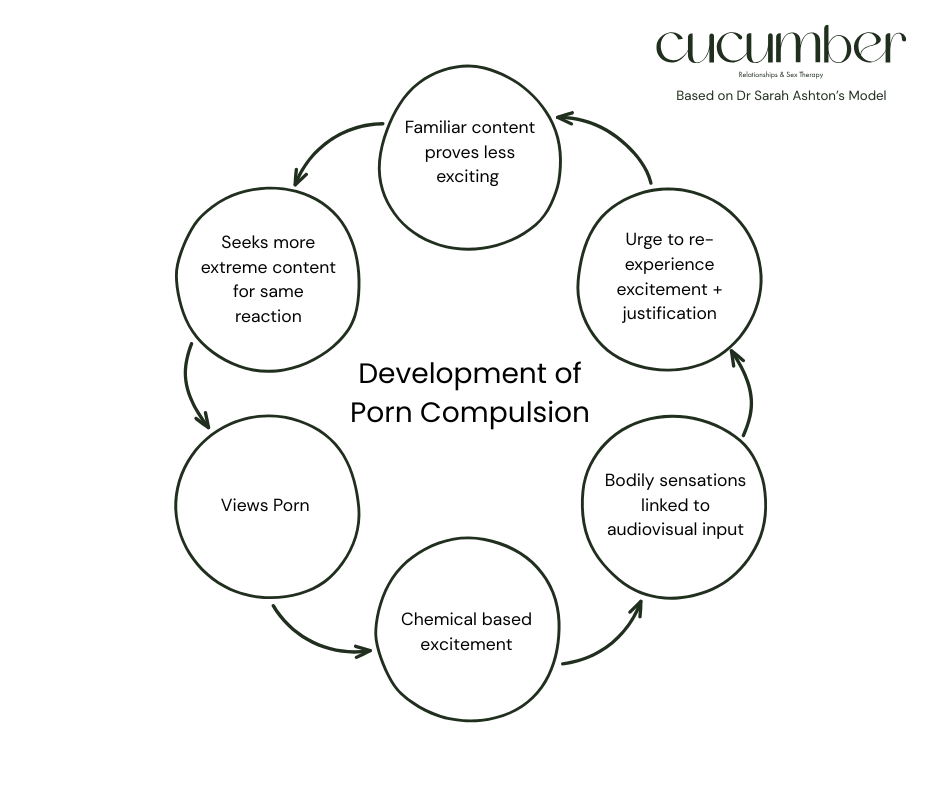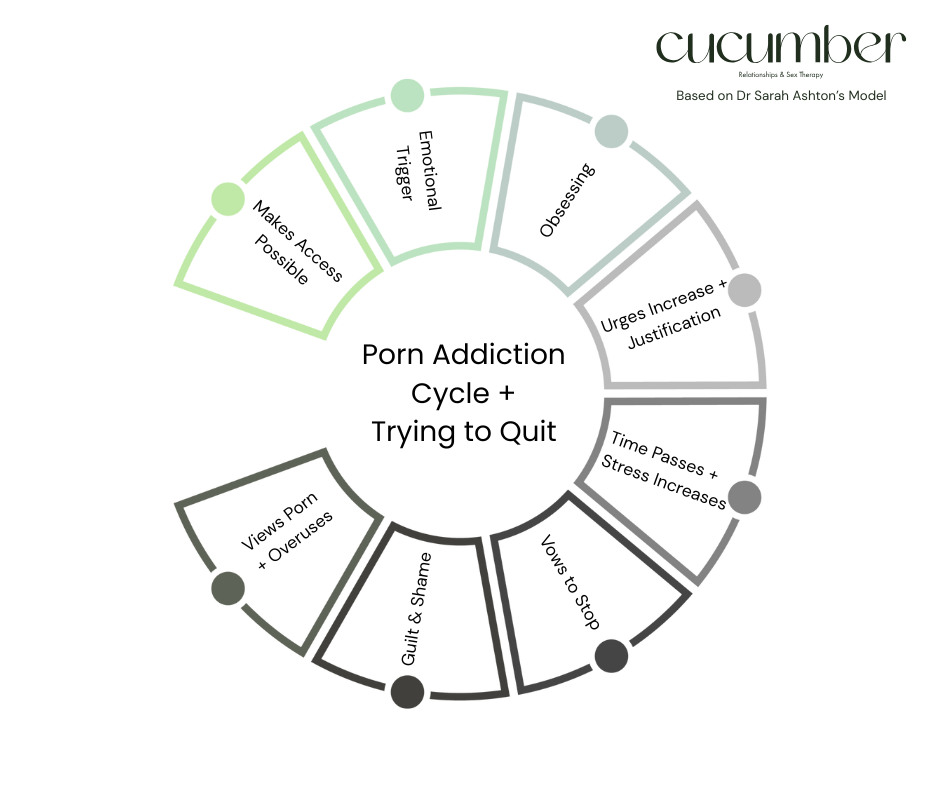Understanding Pornography Addiction: Is it real? (Spoiler: YES!) Can it be treated? (Spoiler: Also yes)
Porn addiction is a contested condition in the sector I work within. I remember it being debated greatly during my sexology degree. Does it meet the criteria for addiction? Are we demonising masturbation? Is porn addiction fear mongering? Is it just an extension of the social taboo of sex work and kink?
I left that degree believing that porn addiction did not exist.
I then started practicing as an actual sex therapist.
People would come into my office in immense distress, reporting feeling strong compulsions, a sense of being out of control, and deep grief about how this was impacting their sex lives. I also came across the work of Dr. Sarah Ashton. Dr. Ashton is one of the amazing clinicians leading the charge globally in her research and advocacy for porn addiction to be taken seriously.
I now strongly believe that we, as clinicians, are only just starting to grapple with the very serious impacts of porn on the brain, the sexual response cycle, and individual’s emotional wellbeing. Not to mention the broader implications for generations of people whose sexual development occurs in the context of porn’s increasing availability.
It’s a big topic and it can be overwhelming. So let’s focus it on what you need to know. Perhaps you struggle with porn addiction, suspect you may have an unhealthy relationship with it, or have a loved one who does. By the end of this article you should have a much better understanding of what porn addiction is and how it develops.
Porn, like many forms of sexual expression, can be a healthy and enjoyable part of a person’s life. For some people, it adds variety, playfulness, and pleasure to their sexual experiences, either alone or with a partner. Many use porn without difficulty and see it as a positive element in their erotic world. This article is not for or about these people.
But sometimes, what began as a fun addition starts to feel compulsive, disconnected from one’s authentic sexual self, and/or necessary for arousal. This isn’t about “good” or “bad” sexual choices — it’s about when porn no longer feels like it’s adding to your sex life, and instead feels like it’s limiting your sexual well-being, relationships, or sense of self.
I often hear a version of the same sentence from clients who come to see me for help in this area:
“I just want this to go away.”
Wishing for immediate change makes sense. When something is causing distress or tension, we want it gone as quickly as possible. But trying to stop porn use without understanding the deeper causes and implications often means relapsing into the same behaviour — often with increasing intensity.
It is not a failure of willpower to struggle with porn and there is nothing shameful about needed help to make a change. The instinct is to simplify the answer, quit cold turkey, demonise it, say it’s just a matter of self-control. Cruel self-talk can often emerges here and it doesn’t help.
Instead of framing porn as the “problem,” therapy explores the bigger picture: the role it’s playing in your life, the needs it’s meeting, and how you want your sexual expression to feel moving forward. It is supportive, nuanced, and cuts through the shame.
How Compulsive Porn Use Develops
Dr Sarah Ashton’s work offers a helpful model of how a sexual behaviour that starts out as a positive addition to masturbation can gradually become compulsive. This is not inevitable for everyone, but when it happens, the process often follows a recognisable pattern.
Views porn: The sensory experience of visuals, sound, and the content is registered by the brain.
Chemical-based excitement: Arousal, dopamine, and adrenaline are released and recognised in the body and brain as a strong experience of pleasure and excitement that can feel all-consuming.
Bodily sensations linked to audiovisual input: The brain links what’s seen with the pleasurable feelings it produced, often creating an unconscious belief that porn is an easily accessible pathway to feel good quickly, intensely, and eliminate/release stress temporarily. Meaning it’s more likely to be desired and accessed.
Urge to re-experience excitement + justification: Unique triggers emerge in life that give rise to the urge to re-experience the intense and easily accessible sexual excitement (stress, loneliness, boredom, sexual desire, numbness, low-self worth etc). Accompanied by internal reasoning (“I just need a break”, “I deserve this”, “It’s harmless”)
Familiar content proves less exciting: Over time, the same content does not hold the same adrenalin rush that emerges from surprise or taboo, leading to lessened immediate sexual excitement.
Seeks more extreme content for same reaction: To re-experience the same level of intense sexual excitement more extreme content is searched for to produce adrenaline to the necessary levels to intensify the experience of arousal and dopamine.
Over time the pattern becomes more ingrained, as porn becomes the answer to a plethora of stressful experiences explored in stage 4 of the cycle (stress, loneliness, boredom, sexual desire, numbness, low-self worth etc), and more extreme content is needed to uphold the cycle. As sexual arousal is experienced with increased frequency within this context, the brain optimises this pathway making it harder to experience arousal in alternative contexts (e.g. without porn or with a sexual partner).
As the distress of the porn use increases, often immediate relief is sort to self-sooth, leading to the brain providing a solution to relief the stress - accessing more porn. This leaves people stuck in a cycle.
The Cycle of Porn Addiction (+ Trying and Failing to Quit)
Once the behaviour becomes compulsive, many try to exit out of the cycle that results in so much distress, but this results in the development of a new cycle - the porn addiction cycle.
Views porn and overuses: Gains short-term relief or stimulation, but the deeper needs remain unmet. The sense of compulsion driving the behaviour results in a feeling of helplessness and binge watching.
Guilt and shame: The emotional fallout intensifies upon conclusion of orgasm, increasing the distress. Unmet needs that prompted use are not compounded by guilt, shame, and helplessness.
Vows to stop: A genuine pledge to stop or reduce use arises to address the emotional distress. An immediate change is desired, reflecting the same pattern that prompts the porn use in the first place. Immediate gratification and distress minimisation.
Time passes and stress increases: Emotional needs remain unaddressed, creating vulnerability to stress increasing. Compounded by the lack of alternative coping mechanisms and sustainably increased tolerance for stress or alternative trigger.
Urges increase and justification: As the stress increases, so to do the urges. More mental energy is needed to resist and becomes exhausting to uphold, resulting in rationalising a return to the behaviour. (“It’ll only be once”, “I just need to take the edge off”, “I deserve to feel good”, “Everyone does this”, “I just need to get it out of my system”.)
Obsessing: Mental focus narrows onto porn. It can feel challenging to engage in relationships, work, and everyday tasks. The urge feels all consuming. It feels difficult to function.
Emotional trigger: The final straw. An emotional trigger arises that seemingly make the distress of not engaging in porn more emotionally painful than viewing porn. The shame and guilt of stage 2 feels distant.
Makes access possible: Creating opportunity to view porn — looping back to step one.
Remember that everything exists on a spectrum.
Some people will experience these cycles with more intensity than others. Some can exit out of the cycle by themselves, others struggle. For some the cycle occurs daily, others it’s over the span of a year. The viciousness of the cycle is the way it spirals into greater and greater intensity over time.
If reading this brings something difficult up for you please note whatever it is with kindness and bravery. You are not alone.
Why Therapy Works — and Why It’s Different for Everyone
Therapy isn’t a quick fix. Let’s be honest about that from the start. Quick fixes are at the heart of what sustains the porn addiction cycle, and my job is to help people out of it. It can be challenging - and my client’s and I can end up going on significant side quests to address some of the underlying factors that contribute to the compulsive pattern arising in the first place. We don’t want to see positive change with porn only for the pattern to emerge with some other compulsive behaviour after all!
Therapy doesn’t judge or impose a single “right” way to engage with porn, masturbation, or sex. In fact, it’s often not directly about masturbation at all. It’s about a client’s unique relationship to the underlying triggers and maladaptive coping skills that give rise to compulsive behaviour and long-term distress. Ideally, at the end of therapy, a client’s relationship to sex, pleasure, porn, and masturbation is one that feels aligned to their values and a natural extension of themselves.
Therapy also addresses the things that often coincide with porn addiction like erectile dysfunction, kink acceptance, anxiety, depression, self-worth, and relational concerns.
For some, the work directly involves unpacking sex and relationships. This often means re-centring your authentic experiences of sexual joy, intimacy, and pleasure, and identifying and changing relational patterns that may make authenticity difficult in those realms.
For others, it involves trauma therapy — understanding how past unprocessed experiences that can reach back into childhood shape current coping patterns and sexual responses. Sex is often a realm where unconscious distressing memories can be highly influential.
Many learn to recognise and move through stress or distress in healthier, more sustainable ways, so that sexual expression becomes a choice rather than a default escape.
In therapy, we might:
Identify the emotions and circumstances that most often precede porn use.
Build tolerance for uncomfortable feelings without needing to avoid them.
Develop alternative ways to meet emotional and sexual needs.
Expand your erotic imagination beyond what the cycle has narrowed it to.
The Bigger Picture
Doing this work is rarely just about reducing porn use — it’s about creating a more spacious, flexible, and fulfilling sexual and emotional life. Clients often find that alongside the original goal, other changes happen too:
Improved relationships — more openness, intimacy, and empathy.
Greater self-worth — feeling more confident and self-accepting sexually and emotionally.
Emotional resilience — better able to navigate stress without collapsing into old patterns.
A richer sexual life — either solo or with partners as its more connected to genuine desire.
Recovery, in this sense, isn’t about giving up sexuality. It’s about reclaiming it in a way that feels nourishing, authentic, and truly your own.
By understanding both how compulsive porn use can develop and how the cycle maintains itself, the focus can shift from self-blame to self-understanding. When working to change the pattern, it will always be better to work smarter and not harder. Whether working with the assistance of a professional, or individually, it is important to recognise the very real way porn addiction exists in people. It is a serious and debilitating experience for many, and more and more people struggle with it as times goes on.
AI chatbots, AI generated porn, and even VR porn addiction are increasing concerns for my clients.
The field continues to develop, intensify, and all within the context of many people struggling with mental health at ever increasing rates and other forms of instant gratification becoming increasingly normalised (yes, it’s the social media and Amazon Prime of it all).
By Emma Vasey
Lead Psychotherapist, Couples Counsellor, and Psychotherapist at CUCUMBER
If any of this brought up significant distress, please know that Lifeline is available on 13 11 14.
Emma Vasey is currently accepting new clients at CUCUMBER’s Port Melbourne office, and across Australia via Telehealth appointments.



